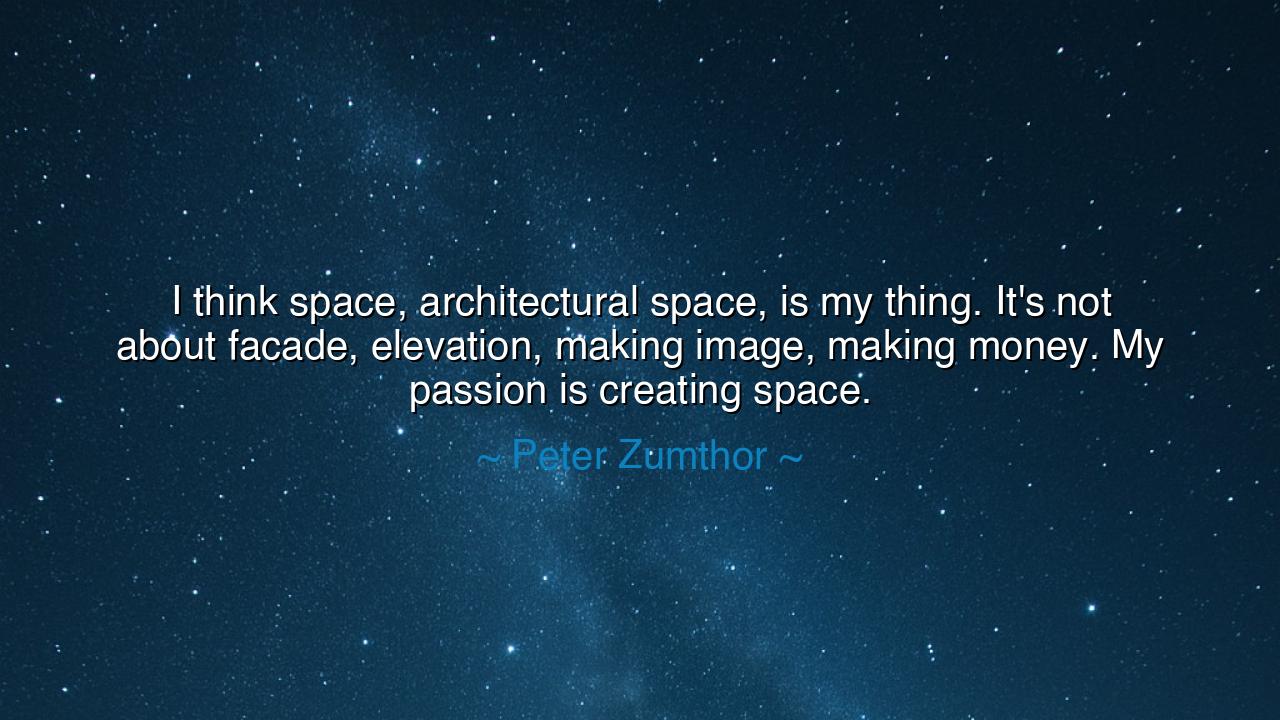
I think space, architectural space, is my thing. It's not about
I think space, architectural space, is my thing. It's not about facade, elevation, making image, making money. My passion is creating space.






Hear the words of Peter Zumthor, master builder and poet of stone and light, who declared: “I think space, architectural space, is my thing. It's not about facade, elevation, making image, making money. My passion is creating space.” In these words, he reveals the essence of true architecture—not the surface, not the glittering skin that dazzles the eye, but the soul of a structure: the space within, where life unfolds and memory dwells. For the facade is but a mask, but the inner chamber, the lived atmosphere, is the dwelling of the human spirit.
The origin of this truth lies deep in the ancient understanding of architecture as a sacred art. When men first raised temples to the gods, they were not concerned with spectacle for its own sake, but with crafting a place where the divine could be felt. The great sanctuaries of Egypt, the temples of Greece, the basilicas of Rome—each sought to shape space so that those who entered would feel awe, reverence, and connection. Zumthor, though of our time, walks in this lineage, seeing architecture not as commerce but as communion, not as display but as atmosphere.
Consider the tale of the Pantheon in Rome. From the outside, it is grand, yes, but many facades are grand. Its true wonder is revealed within, beneath the vast dome that seems to open the heavens themselves. When the sunlight pours through the oculus, illuminating the chamber, one feels not simply enclosed by walls, but embraced by the cosmos. This is what Zumthor means: space, carefully crafted, has the power to stir the soul, to remind man of his place in the universe. The facade may impress, but the space transforms.
So too in Zumthor’s own works—his Therme Vals baths in Switzerland, carved into the mountain stone, create not spectacle for the eye alone, but an atmosphere for the body and spirit. To walk within is to feel time slow, to feel earth and water and silence intertwine. The space itself becomes an experience, a meditation, a healing presence. This is the architecture of passion—not the chasing of image, not the pursuit of money, but the crafting of living spaces where people may encounter themselves, each other, and the world anew.
And here is the lesson: in all our creations—be they houses, songs, businesses, or even relationships—we must ask: are we building facades, or are we creating space? Facades impress from afar, but space sustains those who dwell within it. A friendship that is only surface will crumble; a work of art that is only spectacle will fade. But a creation rooted in sincerity, in inner depth, in the shaping of true experience—this endures. To build space is to care for life itself.
The wisdom extends beyond architecture into the way we live. Do not spend your energy only on appearances, on elevation, on image. These are fleeting masks. Instead, cultivate inner rooms—time for reflection, depth in your work, warmth in your home, sincerity in your words. Create spaces within your life where others may find rest, joy, and inspiration. For just as Zumthor scorns the empty pursuit of facades, so too should we reject the hollow chase of appearances and choose instead to build atmospheres of meaning.
Therefore, O listener, heed this teaching: let your passion be not for display, but for creation. Let your craft, whatever it may be, form spaces where life can breathe. Whether you are a builder of houses or of families, a maker of art or of friendships, strive not for the shallow facade, but for the inner harmony that shelters the human soul. For in the end, the facades will fade, the images will pass, the money will vanish—but the space you create, whether in stone or in spirit, will endure as a dwelling for generations.






AAdministratorAdministrator
Welcome, honored guests. Please leave a comment, we will respond soon